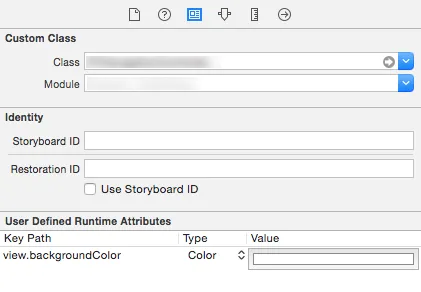当我在主-细节导航控制器的父子控制器之间来回导航时,我会看到导航栏顶部右侧有一个深色阴影。这是在我升级到Xcode 5.1后出现的。它感觉很粗糙,很分散注意力。我该如何摆脱它?
升级到Xcode 5.1和iOS 7.1后,在segue转换期间导航栏出现了黑暗阴影。
95
- Nihat
13个回答
145
self.navigationController.view.backgroundColor = [UIColor whiteColor];
我通过设置导航控制器视图的背景颜色来解决了这个问题。
- nonamelive
5
57
self.navigationController.navigationBar.translucent = NO;
适用于较新的 Swift 版本:
navigationController?.navigationBar.isTranslucent = false
- Nihat
7
你把这个放在哪里了? - Zorayr
在主视图控制器的ViewDidLoad方法中 - Nihat
在 viewDidAppear 中添加。 - Abdul Waheed
1@Annjawn,
navigationController.view.backgroundColor = .white在iOS 12上可行。移除导航栏的半透明效果可能在某些情况下不合适,但黑色阴影则可以使用。 - Alex Motor上帝保佑你健康。 - Booharin
显示剩余2条评论
37
- manmal
4
1我更喜欢这种方法,让Interface Builder尽可能处理UI相关的事情。 - DazChong
iOS 8.4 没有帮助。 - Yaroslav Dukal
3可与Xcode 8.3.3完美配合使用。强调一下,必须在
UINavigationController上设置,而不是在viewController上。 - jungledev我在一个选项卡控制器中使用了导航控制器,并且在其中一个导航控制器的视图控制器上使用了“推送时隐藏底部栏”,导致两个栏(顶部和底部)都出现了阴影。将导航控制器的白色背景设置为解决了这个问题。谢谢! - nh32rg
6
这似乎是在iOS 7.1中引入的错误。在我的情况下,它是由放置在导航栏直接下方的UIToolbar引起的。暗阴影也会出现在半透明的选项卡栏中。
这个阴影似乎是由UIToolbar的背景视图引起的。我现在在具有工具栏的视图控制器中使用此解决方法,它在过渡期间隐藏了工具栏的背景视图:
这是
这个阴影似乎是由UIToolbar的背景视图引起的。我现在在具有工具栏的视图控制器中使用此解决方法,它在过渡期间隐藏了工具栏的背景视图:
- (void)viewDidAppear:(BOOL)animated
{
[super viewDidAppear:animated];
UIView *toolbarBackgroundView = [self.toolbar findViewRecursively:^BOOL(UIView *subview, BOOL *stop) {
BOOL isToolbarBackgroundView = ([subview isKindOfClass:[UIImageView class]]
&& [NSStringFromClass(subview.class) isEqualToString:@"_UIToolbarBackground"]);
if (isToolbarBackgroundView) {
*stop = YES;
}
return (! isToolbarBackgroundView);
}];
if (toolbarBackgroundView) {
// fade toolbar background view back in
[UIView animateWithDuration:0.1f animations:^{
toolbarBackgroundView.alpha = 1.0f;
}];
}
}
- (void)viewWillDisappear:(BOOL)animated
{
[super viewWillDisappear:animated];
UIView *toolbarBackgroundView = [self.toolbar findViewRecursively:^BOOL(UIView *subview, BOOL *stop) {
BOOL isToolbarBackgroundView = ([subview isKindOfClass:[UIImageView class]]
&& [NSStringFromClass(subview.class) isEqualToString:@"_UIToolbarBackground"]);
if (isToolbarBackgroundView) {
*stop = YES;
}
return (! isToolbarBackgroundView);
}];
if (toolbarBackgroundView) {
// hide toolbar background view
toolbarBackgroundView.alpha = 0.0f;
}
}
这是
[UIView findViewRecursively:]代码的内容。@interface UIView (FindSubview)
- (UIView*)findViewRecursively:(BOOL(^)(UIView* subview, BOOL* stop))recurse;
@end
@implementation UIView (FindSubview)
- (UIView*)findViewRecursively:(BOOL(^)(UIView* subview, BOOL* stop))recurse {
for (UIView* subview in self.subviews) {
BOOL stop = NO;
if (recurse(subview, &stop)) {
UIView* view = [subview findViewRecursively:recurse];
if (view) return view;
} else if (stop) {
return subview;
}
}
return nil;
}
@end
我提交了这个Radar:http://openradar.appspot.com/16418845
(意思是作者提交了一个关于it技术的问题反馈链接)- tom
3
2如果您不需要半透明的导航栏,那么您的解决方案就很好。 - tom
有一个更简单的方法来获取
backgroundView。 [self.toolbar valueForKey:@"_backgroundView"]。请注意,这是一个私有API,但我认为你不会被苹果抓到,因为 _backgroundView 只是一个通用名称。 - nonamelive这个答案提示了我需要做什么。在我的情况下,只需在界面构建器中取消选中UIToolbar上的半透明选项即可。 - Greg W
5
这对我在Swift中非常有效。
在AppDelegate的didFinishLaunchingWithOptions方法中,我设置了以下内容:
在AppDelegate的didFinishLaunchingWithOptions方法中,我设置了以下内容:
UIApplication.shared.windows.first?.backgroundColor = .white
- pableiros
5
这对我来说在上都可以工作,并且支持浅色和深色主题,也适用于旧版iOS。
将以下代码添加到AppDelegate的application(didFinishLaunchingWithOptions)方法中:
if #available(iOS 13.0, *) {
window?.backgroundColor = UIColor.systemBackground
} else {
window?.backgroundColor = UIColor.white
}
- petrsyn
1
2我也尝试过这种方法,但是在默认模式下呈现视图控制器时遇到了问题。然后你会看到窗口的白色背景而不是黑色的。那看起来很奇怪。你能否提供任何想法来克服这种情况? - varun v nair
4
似乎任何半透明的工具栏(TabBar或ToolBar)都会出现这种情况。
因此,一种解决方法是设置_tabBar.translucent = NO;(在我的情况下)。这可以防止顶部导航栏下的不必要阴影,同时保持导航栏半透明。不幸的是,底部工具栏不再是半透明的。
它可以重新设置为半透明,但所有这些都必须在整个推送动画完成后才能发生,因此切换此属性非常明显。
然而,如果底部工具栏也必须是半透明的,而我不希望用户看到这种变化,我使用以下方法进行解决:
/* create a simple quick animation of the bottom bar
just before pushing the new controller */
[UIView animateWithDuration:0.1
animations:^{
_tabBar.barTintColor = [UIColor colorWithWhite:0.97254901960784 alpha:1.0]; // this is the closest color for my case
_tabBar.translucent = NO;
} completion:^(BOOL finished) {
/* now when the animation that makes the bar not translucent
is finished we can push the new controller
the controller is instantiated before the animation code */
[self.navigationController pushViewController:controller animated:YES];
}];
然后在
viewDidAppear: 中,我只需将其恢复回来:[UIView animateWithDuration:0.1
animations:^{
_tabBar.barTintColor = nil;
_tabBar.translucent = YES;
}];
外观上只有一点点变化,但几乎不会被注意到,而且比导航栏下面有阴影要好得多。
希望这能帮助其他人在苹果修复此行为之前保持条形透明,因为在某些情况下,栏目确实应该被隐藏,尤其是对于UITabBar。
- kacho
1
我通过采用@manmal的解决方案成功修复了这个问题——在故事板中为您的UITabBarController定义运行时属性
view.backgroundColor,并将其设置为白色。 - jamesk3
self.navigationController!.navigationBar.translucent = false;
这对我很有效,将其放入您推送新 ViewController 的函数中。
- Shyam Raju
1
疯狂的是,在所有答案中,将其放置在推到下一个VC的函数中的想法是最好的! - Coltuxumab
3
这是我的变体……它比汤姆的回答需要更少的代码,并且更有效。如果你想要一个半透明的导航栏,同时还想解决阴影问题,可以采用这种方法。
在源View Controller中(嵌入在导航控制器中)…
在源View Controller中(嵌入在导航控制器中)…
- (void)viewDidAppear:(BOOL)animated
{
self.navigationController.navigationBar.translucent = YES;
}
并且
- (void)viewWillDisappear:(BOOL)animated
{
self.navigationController.navigationBar.translucent = NO;
}
结果与Tom执行的操作相同(从视觉上,对终端用户而言),并且更容易实现。希望这可以帮到您...
- user2734823
3
以下内容同样适用且将导航栏保持透明:
[UIApplication sharedApplication].keyWindow.backgroundColor = [UIColor whiteColor];
[UIApplication sharedApplication].keyWindow.backgroundColor = [UIColor whiteColor];
- seb
网页内容由stack overflow 提供, 点击上面的可以查看英文原文,
原文链接
原文链接

darkColor的视图,并导致了这个问题。 - superarts.org